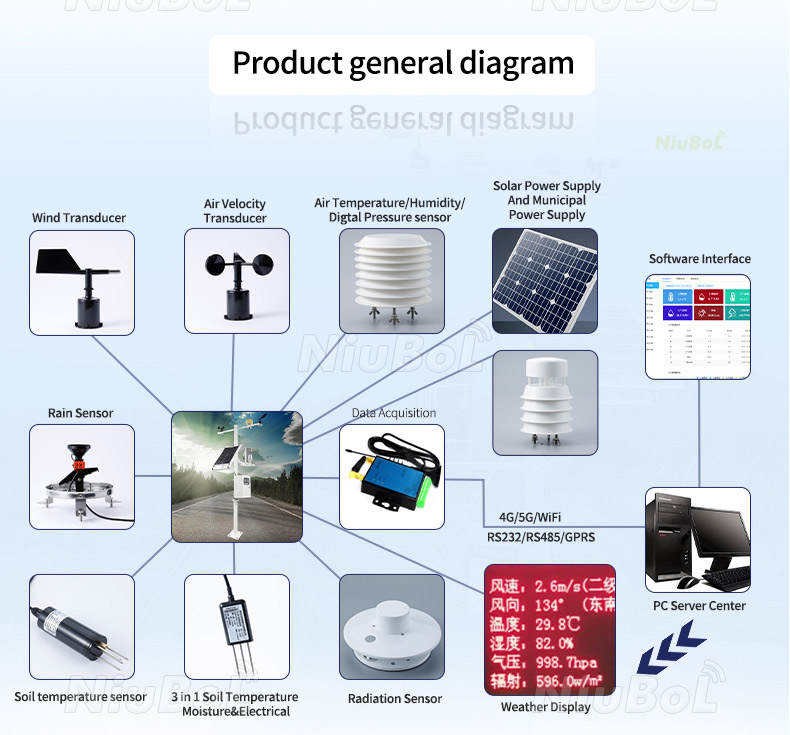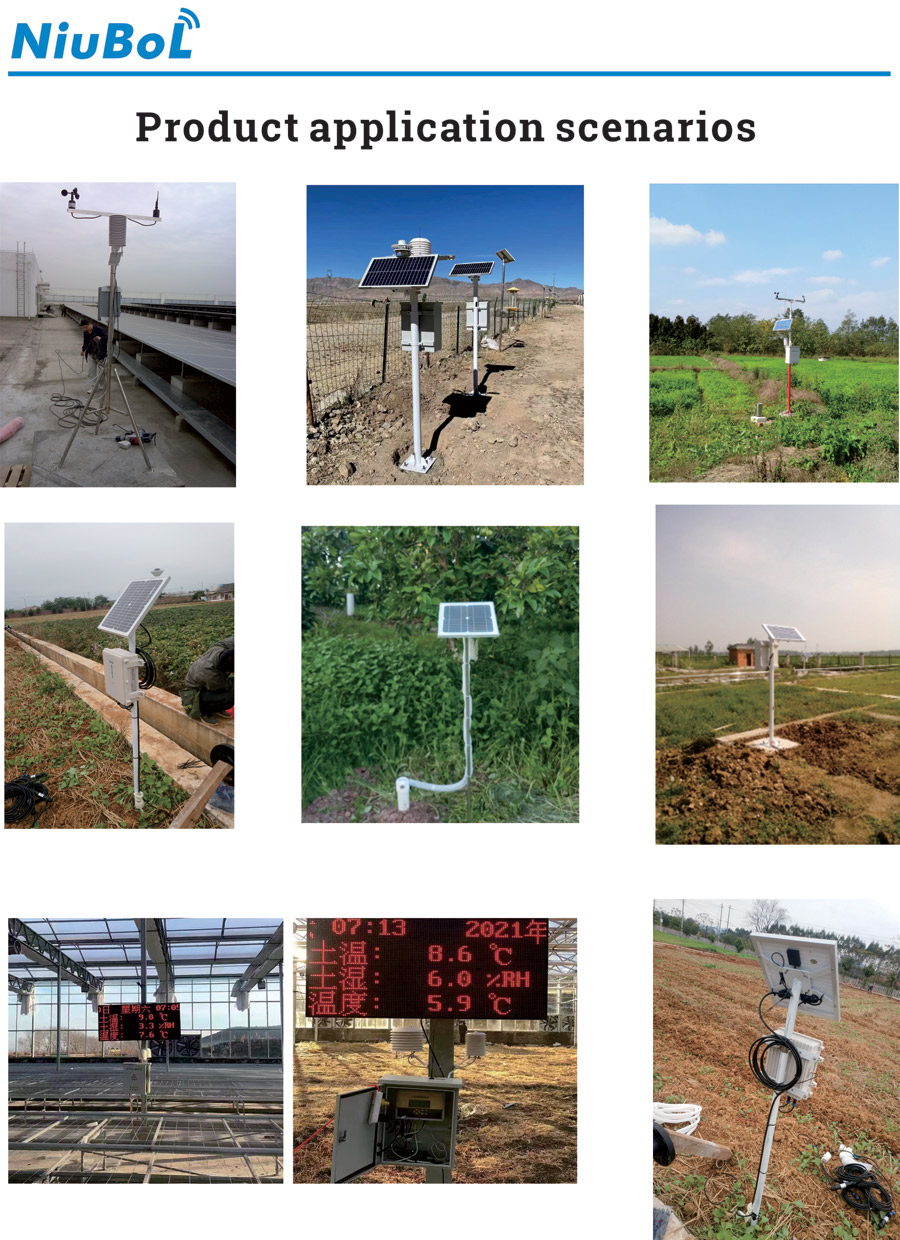

— Blogs —
—Products—
 Consumer hotline +8618073152920
Consumer hotline +8618073152920 WhatsApp:+8615367865107
Address:Room 102, District D, Houhu Industrial Park, Yuelu District, Changsha City, Hunan Province, China
Technical Support
Time:2024-01-20 19:43:49 Popularity:1559
Sensor failure: the sensor is the core component of the agrometeorological station, and common failures include aging sensors, reduced accuracy, and abnormal signals. Regular maintenance and calibration are required to ensure the normal operation of the sensors.
Communication faults: Agrometeorological stations usually need to transmit data to the data centre for analysis and processing. If the communication equipment fails or the signal is blocked, it may lead to interrupted or unstable data transmission. It is necessary to check the communication equipment and signal transmission condition to keep the communication smooth.
Power failure: Agricultural meteorological stations are usually installed in the field or farmland, and the power supply equipment may be unstable or damaged, resulting in the equipment not working properly. It is necessary to check and maintain the power supply equipment regularly to ensure its normal power supply.
Installation Location Problem: The installation location of the agrometeorological station may affect its monitoring effect, such as choosing the edge of the farmland or a place with a lot of shelter may affect the accuracy and reliability of the data. It is necessary to choose a suitable location for installation and maintain the stability and safety of the equipment.
Data anomalies and errors: Data collected by agrometeorological stations need to be processed and analysed, and if there are anomalies or errors in the data, it may affect the growth and management of crops. The data need to be calibrated and checked regularly to ensure its accuracy and reliability.
Damaged and stolen equipment: The equipment in the agrometeorological station may be damaged or stolen, and the protection and security management of the equipment need to be strengthened.
In order to ensure the stable operation of the agrometeorological station and the accuracy and reliability of the data, there is a need to carry out regular maintenance and servicing of the equipment, to deal with faults and problems in a timely manner, and to strengthen communication and collaboration with the data centre. It is also necessary to continuously improve and optimise the monitoring technology and data processing capacity of agrometeorological stations to enhance their reliability and accuracy.

The following points can be considered as solutions for sensor failures in agrometeorological stations:
Regular maintenance and calibration: the sensor is regularly cleaned, maintained and calibrated to ensure its proper operation and accuracy. Calibration allows for adjustments and corrections to be made to the sensor's measurements by comparing it to a standard instrument.
Checking the connecting part: The connecting part between the sensor and the weather station may be loose or damaged, resulting in abnormal data transmission. The connection part needs to be checked regularly to ensure that it is firm and reliable.
Data anomaly detection: By monitoring the data changes of the sensor in real time, anomalies can be detected and dealt with in a timely manner. For example, if the sensor data suddenly fluctuates drastically or remains unchanged for a long time, the sensor needs to be inspected.

Use of spare sensors: In order to cope with sensor failure, spare sensors can be equipped. Once the main sensor fails, the spare sensor can be replaced in time to ensure the normal operation of the weather station.
Strengthening protective measures: For some sensors that are easily affected by the outside world, such as wind, rain, lightning, etc., it is necessary to strengthen the protective measures, such as installing a rain cover and lightning rod.
Contact with the manufacturer: If none of the above methods can solve the problem, it is recommended to contact the manufacturer or supplier of the sensor to seek professional technical support and maintenance services.
To sum up, solving sensor failures of agricultural weather stations requires comprehensive consideration of many aspects, including regular maintenance, checking the connection part, detecting data anomalies, the use of spare sensors, strengthening protective measures and contacting the manufacturer. At the same time, managers and users of weather stations also need to accumulate experience and improve their technical level to ensure the stable operation of weather stations and the accuracy and reliability of data.
Related recommendations
Sensors & Weather Stations Catalog
Agriculture Sensors and Weather Stations Catalog-NiuBoL.pdf
Weather Stations Catalog-NiuBoL.pdf
Related products
 Combined air temperature and relative humidity sensor
Combined air temperature and relative humidity sensor Soil Moisture Temperature sensor for irrigation
Soil Moisture Temperature sensor for irrigation Soil pH sensor RS485 soil Testing instrument soil ph meter for agriculture
Soil pH sensor RS485 soil Testing instrument soil ph meter for agriculture Wind Speed sensor Output Modbus/RS485/Analog/0-5V/4-20mA
Wind Speed sensor Output Modbus/RS485/Analog/0-5V/4-20mA Tipping bucket rain gauge for weather monitoring auto rainfall sensor RS485/Outdoor/stainless steel
Tipping bucket rain gauge for weather monitoring auto rainfall sensor RS485/Outdoor/stainless steel Pyranometer Solar Radiation Sensor 4-20mA/RS485
Pyranometer Solar Radiation Sensor 4-20mA/RS485
Screenshot, WhatsApp to identify the QR code
WhatsApp number:+8615367865107
(Click on WhatsApp to copy and add friends)
